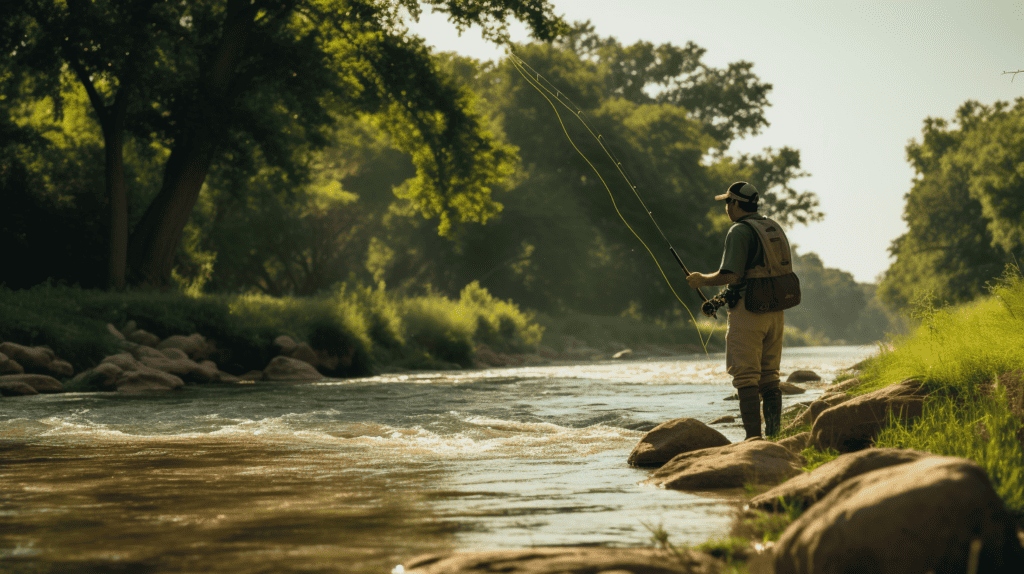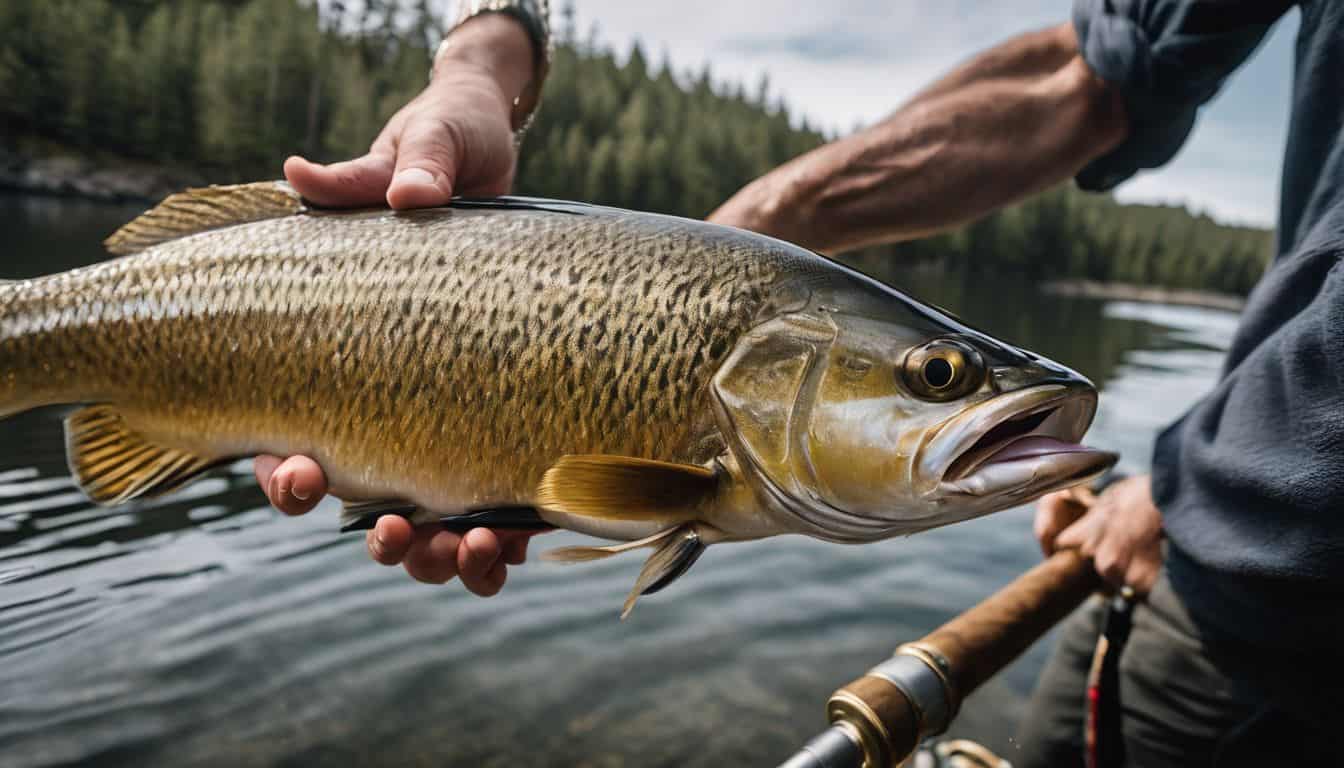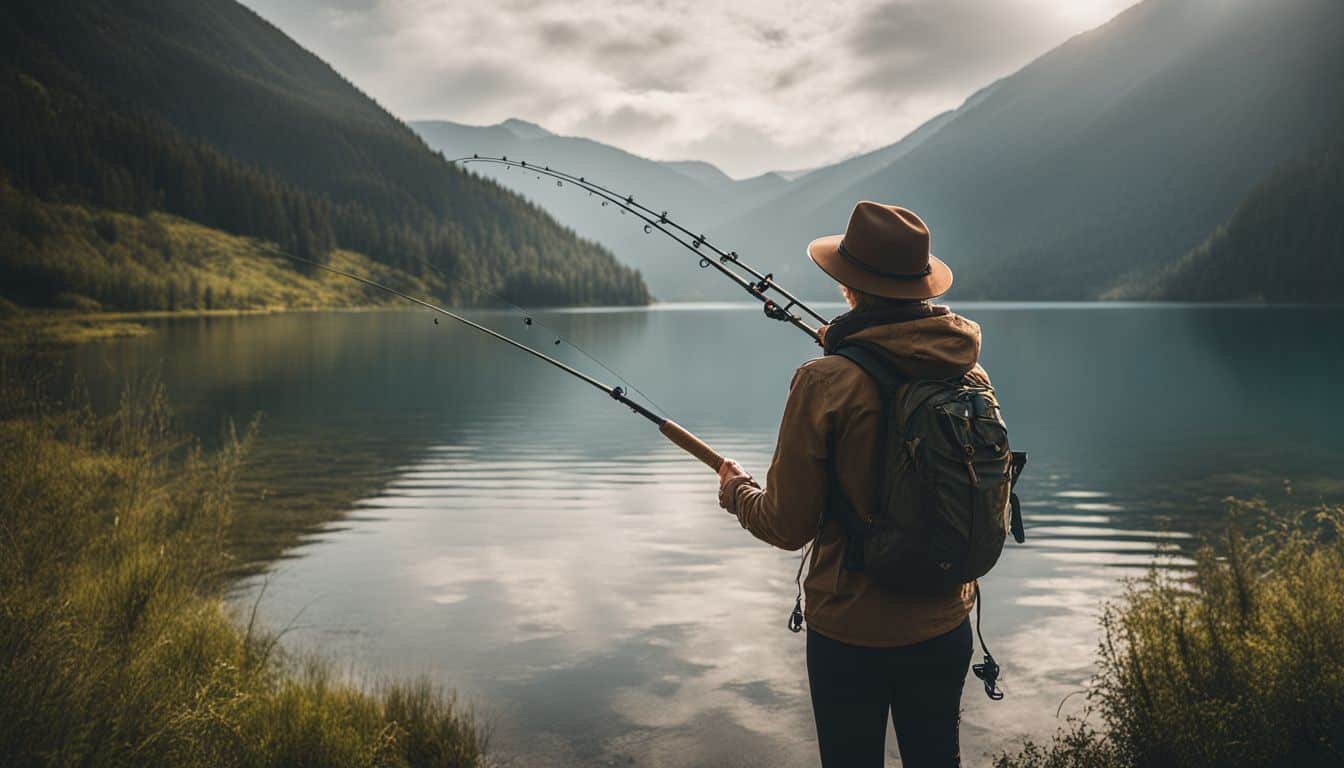Navigating the sea of fishing rod options can feel a bit like being adrift without a paddle, believe me. Thankfully, I’ve managed to map out this somewhat murky territory through extensive research and hands-on experience.
My mission? To guide you unerringly towards your perfect tackle companion! This article will serve as your comprehensive compass by covering all bases – from length and material to action.
It’s also primed to answer some burning questions: ‘Which rod should beginners gravitate towards?’ or ‘How does Mother Nature influence my pick?’. So let’s cast away into an ocean of knowledge together, shall we?
Key Takeaways
- Choose the right fishing rod length based on your casting distance and maneuverability needs. Short rods are easy to manage, long rods are for far casting, and medium rods give you both options.
- Understand the different materials used in fishing rods: fiberglass is strong, graphite provides better feel of fish bites, and composite mix rods offer a combination of strength and feel.
- Know the difference between fast, medium, and slow action rods. Fast action provides more casting distance and hook-setting power, while slow action gives a smooth cast but may lack control for bigger fish.
- Consider factors like your fishing style, target species, line weight capacity, flexibility, and action when determining the right rod power for your needs.
Understanding Fishing Rod Length and Material
Choose the right rod length for your fishing needs by considering factors like casting distance and maneuverability.
Choosing the right rod length
Picking the right rod length is key to a good fishing trip. Rods come in different sizes, each with its own use. Short rods are easy to manage and perfect for close range. But if you need to cast far, pick a long rod.
Medium rods that are 7 to 9 feet long give you both near and far casting options. It’s not just about range though, the right size can also affect how well you spot fish bites. So choose your rod length based on what feels best for you and fits your fishing style.
Exploring different rod materials (fiberglass, graphite, composite)
Fishing rods come in different types. One kind is the fiberglass rod. This rod uses fine glass fibers put together to make it strong. Another type is the graphite rod. It’s made with carbon fibers, so it’s stiff and you can feel a fish bite better.
The third type mixes both materials. They call this composite mix rods. Here you get both the strength from glass fiber and the nice feel of carbon fiber in one neat package! Each material has its own good points, so pick what works best for your fishing style.
Decoding Rod Action and Power
To understand the rod action, it’s important to know that fast-action rods bend mostly at the tip, while slow-action rods bend throughout the entire length.
Understanding fast, medium, and slow action rods
Fast, medium, and slow action rods are all about how much a rod bends. A fast action rod flexes in the top third part only. This gives more casting distance and better hook setting power.
Medium or moderate action rods bend at the upper half area. They add more flexibility to your casting motion. Slow action rods bend from tip to handle. These give you a smooth cast for small fishes yet may lack control for bigger ones! Each type of rod looks different when it bends due to its ‘action’.
Knowing this will help you pick the best one for your fishing goals.
Determining the right rod power for your fishing style
Choosing the right rod power for your fishing style is crucial. Here are some important factors to consider:
- Know your fishing style: Determine whether you prefer to fish with heavy lines and lures or if you enjoy light tackle fishing.
- Consider the target species: Different fish species require different rod powers. Research the recommended power for the type of fish you plan to catch.
- Think about line weight capacity: The power rating of a fishing rod corresponds to its line weight capacity. Make sure your chosen rod can handle the weight of the line you intend to use.
- Understand rod flexibility: Power refers to how much force it takes to bend the rod. Consider whether you need a stiffer or more flexible rod based on your fishing technique and target species.
- Look at rod action: Action refers to where in the rod it starts to bend. Faster action rods bend closer to the tip, while slower action rods bend throughout their length. Choose an action that suits your casting and hook-setting preferences.
Examining Rod Markings and Other Parts
When examining rod markings, it is important to understand the significance they hold in determining the specifications and characteristics of a fishing rod.
Importance of rod markings
Rod markings play a crucial role in selecting the right fishing rod. They provide important information about the rod, such as its length and other specifications. By examining these markings, we can determine the line weight ratings and lure weight range suitable for the rod.
Additionally, proper alignment of the guides, as indicated by the rod markings, is essential for optimal performance. Understanding these markings helps us make informed decisions when purchasing a fishing rod.
So, paying attention to rod markings can ensure that we choose a rod that best suits our needs and preferences as anglers.
Exploring rod guides, handles, and other components
As a fishing enthusiast, I want to help you understand the important components of a fishing rod. Let’s explore the world of rod guides, handles, and other key parts:
- Rod guides: These are small rings or loops that guide your fishing line along the length of the rod. They come in different shapes and materials.
- Guide frame composition: The quality of the guide frame affects its durability and performance. Look for sturdy frames made from materials like stainless steel or aluminum.
- Guide material composition: The material used for the guide itself can impact its smoothness and sensitivity. Ceramic, titanium, or even plastic are commonly used materials.
- Casting performance and rod guides: The number and placement of guides on a fishing rod can affect your casting ability. More guides generally result in smoother and longer casts.
- Price and number of rod guides: It’s worth noting that as the number of guides increases, so does the price of the fishing rod. Consider your budget when choosing a rod with the right number of guides for your needs.
- Line weight ratings on fishing rods: Look for line weight ratings printed on the fishing rod. This will help you determine which type and weight of fishing line is suitable for optimal performance.
- Lure weight range on fishing rods: Similarly, check for lure weight range specifications on the rod. This will indicate what size lures work best with your chosen rod.
- Rod sensitivity and guide placement: Sensitivity is an important factor to consider when selecting a fishing rod. Pay attention to where the guides are positioned as this can affect how well you can feel bites or movements underwater.
Considering Fishing Environment and Target Species
When selecting a fishing rod, it’s essential to consider the fishing environment and your target species. Match your rod to the specific conditions you’ll be fishing in, such as freshwater or saltwater, and choose a rod that is suitable for the type of fish you’ll be targeting.
Matching your rod to the fishing environment
Choosing the right fishing rod that matches your fishing environment is essential for a successful day on the water. Different fishing locations and conditions require specific rods to maximize your chances of catching fish.
For example, if you’re fishing in small rivers or tight spaces, a shorter rod will give you better control and maneuverability. On the other hand, if you’re fishing in open areas like lakes or offshore, a longer rod will help you cast farther and cover more ground.
So consider where you’ll be fishing and select a rod that suits those conditions to improve your overall experience.
When it comes to target species, different fish have different habits and behaviors. This means that certain rods may work better for specific types of fish. If you’re targeting smaller freshwater species like trout or panfish, a light or ultralight rod would be suitable as they offer more sensitivity and finesse for delicate presentations.
However, if you’re planning to go after larger game fish like bass or saltwater species such as redfish or tarpon, then a medium-heavy or heavy-action rod will provide the strength needed to handle their powerful fights.
Choosing a rod suitable for your target fish species
Selecting the right fishing rod can greatly improve your chances of catching the fish you’re targeting. Here are some important considerations:
- Know your target fish species – Different fish species have different behaviors and require specific rods. Research which rods work best for the fish you want to catch.
- Consider the fishing environment – The location where you’ll be fishing matters. If you’ll be fishing in a small pond, a shorter rod might be better. For open water or larger lakes, a longer rod might provide more casting distance.
- Determine your skill level – If you’re a beginner, start with a versatile rod that can handle various fishing techniques. As you gain experience, you can invest in specialized rods for specific purposes.
- Look at the recommended rod power – The power of a rod refers to how much force it takes to bend it. Lighter rods are great for smaller fish, while heavier rods are better suited for bigger and stronger fish.
- Pay attention to the action of the rod – The action determines how much the rod flexes when pressure is applied to it. Faster action rods bend mostly near the tip, providing more sensitivity and quicker response time.
- Think about portability – Telescopic rods are compact and easily transportable, making them ideal for traveling or hiking trips.

Evaluating Rod Responsiveness and Sensitivity
To evaluate rod responsiveness and sensitivity, you need to understand their importance in fishing. A responsive and sensitive rod allows you to feel even the slightest nibble from a fish, giving you better control and increasing your chances of success on the water.
Additionally, look for rods with materials like graphite or composite that offer enhanced sensitivity and quick response.
Importance of rod responsiveness and sensitivity
Rod responsiveness and sensitivity are essential factors to consider when selecting a fishing rod. These attributes determine how well the rod can detect even the slightest fish nibbles or bites.
A more responsive and sensitive rod allows for better control, accuracy, and improved chances of hooking fish successfully. Factors such as the materials used, the number and location of guides on the rod, and its overall strength contribute to its responsiveness and sensitivity.
Keep in mind that higher-priced rods tend to offer greater sensitivity, but there are also affordable options available with good responsiveness. Finding a balance between budget and quality is key when it comes to selecting a fishing rod with optimal responsiveness and sensitivity for your needs.
How to identify a responsive and sensitive rod
When choosing a fishing rod, it’s important to find one that is both responsive and sensitive. Here are some tips to help you identify these qualities in a rod:
- Look for a rod made from high-quality materials: Fishing rods made from materials like graphite or carbon fiber tend to be more sensitive and responsive compared to those made from cheaper materials.
- Pay attention to the rod’s action: Rod action refers to how much the rod bends when pressure is applied. Fast action rods bend mostly near the tip, while slow action rods bend throughout the entire length. For increased sensitivity, consider a fast or medium-fast action rod.
- Consider the power of the rod: Power relates to how much force is needed to bend the rod. Light power rods are more sensitive and suitable for smaller fish, while heavier power rods are better for larger fish. Choose a power that matches your target fish species.
- Test the rod’s flexibility: Hold the rod by its handle and give it a slight shake. A sensitive rod will transmit vibrations easily through the handle and into your hand, allowing you to feel even subtle movements or bites.
- Check for a comfortable grip: The handle should fit comfortably in your hand and provide good control over the rod’s movements. Look for handles made from cork or EVA foam, as these materials offer both comfort and durability.
- Consider the placement of guides: Guides are small rings along the length of the rod that guide your fishing line. The spacing and quality of these guides can affect sensitivity by reducing friction and maximizing line movement.
Balancing the Budget and Quality
When it comes to choosing a fishing rod, it’s important to find the right balance between budget and quality.
Finding the right balance between budget and rod quality
When choosing a fishing rod, it’s important to find the right balance between your budget and the quality of the rod. You want to get the most value for your money without sacrificing performance.
Consider looking at different components of the rod that can affect its price, such as materials used and additional features. By understanding your personal preferences and needs, you can choose a fishing rod that fits within your budget while still providing good quality for an enjoyable fishing experience.
Understanding the trade-offs in different price ranges
When choosing a fishing rod, it’s important to understand the trade-offs in different price ranges. The budget you have will impact the quality of the rod you can get. Higher-priced rods usually offer better materials and construction, resulting in improved performance and durability.
However, if your budget is limited, there are still options available at lower price points that can meet your fishing needs. It’s essential to find a balance between your budget and the quality of the rod you choose, ensuring that you get the best value for your money.
Remember to consider factors like materials, length, action, and other features when making your decision.
Ultimate Tips for Fishing Rod Selection Guide
Choosing the right fishing rod can make a big difference in your fishing success. Here are some ultimate tips to help you select the perfect rod:
- Consider your fishing style: Think about the type of fishing you’ll be doing and choose a rod that suits your preferred techniques, such as casting, spinning, or fly fishing.
- Know your target fish species: Different fish require different rods. Research what type of rod is best for the species you plan to catch, whether it’s bass, trout, salmon, or others.
- Determine the appropriate length: Longer rods provide more casting distance while shorter ones offer better maneuverability. Choose a length that matches the fishing environment and your personal preference.
- Understand rod action and power: Rod action refers to how much the rod bends when pressure is applied, while power determines how much force is needed to make it bend. Match these factors with your fishing style and target fish.
- Consider rod materials: Fiberglass rods are durable and flexible, graphite rods are sensitive and lightweight, and composite rods combine the benefits of both materials. Choose based on your budget and fishing needs.
- Test the responsiveness and sensitivity: A responsive and sensitive rod allows you to feel even slight nibbles from fish. Check for this quality by flexing the rod tip gently with your hand before buying.
- Find the right balance between budget and quality: Set a budget range for yourself but remember that investing in a higher-quality rod may give you better performance and durability in the long run.
- Seek expert advice and read reviews: Consult with experienced anglers or professionals who can give you personalized recommendations based on their expertise. Additionally, read reviews online to gather insights from other fishermen.
Seeking Expert Advice and Reviews
Consulting with experienced anglers or professionals in the fishing industry can provide valuable insights and recommendations when it comes to selecting the right fishing rod for your needs.
Additionally, reading reviews from other anglers can help you narrow down your choices and make an informed decision. By seeking expert advice and reviews, you can ensure that you are investing in a high-quality fishing rod that will enhance your fishing experience.
Consulting with experienced anglers or professionals
When selecting a fishing rod, it’s always a good idea to consult with experienced anglers or professionals. They have valuable knowledge and can provide recommendations based on their expertise.
Whether you’re a beginner or an experienced angler, seeking advice from these individuals can help you make the right decision. Experienced anglers or rod builders can suggest the best fishing rod blanks to use, while fly rod manufacturers, fly shop employees, and guides can offer guidance tailored to your skill level.
By consulting with these experts, you’ll gain insight into which fishing rods are suitable for your specific needs and preferences. Their input will ensure that you choose a fishing rod that enhances your overall fishing experience.
Reading reviews and recommendations for fishing rods
As a fishing enthusiast, I know how important it is to make the right choice when it comes to fishing equipment. That’s why I always spend time reading reviews and recommendations for fishing rods before making a purchase. Here are some reasons why you should do the same:
- Expert advice: By reading reviews and recommendations, you can benefit from the knowledge and experience of experienced anglers or professionals who have already tested the fishing rods. Their insights can help you make an informed decision.
- Different perspectives: Reviews allow you to get a variety of opinions on different fishing rods. This can help you evaluate their pros and cons and decide which one would be the best fit for your needs.
- Quality assessment: Reading reviews gives you an idea of the overall quality of the fishing rod. You can learn about its durability, performance, and any potential issues that other users have encountered.
- Features comparison: Reviews often provide detailed information about the features of different fishing rods, such as materials used, weight, flexibility, and sensitivity. This allows you to compare different options and choose a rod that suits your preferences.
- Real-life experiences: Reviews often include personal anecdotes and stories from people who have actually used the fishing rod in various fishing scenarios. This can help you understand how well it performs in real-life situations.
Trying Before Buying and Seeking Warranty
When selecting a fishing rod, it’s crucial to try it out before making a purchase and also check for a warranty. By testing the rod beforehand, you can get a feel for its weight, sensitivity, and overall comfort.
Additionally, seeking a warranty ensures that you have protection in case of any defects or damages.
Testing the rod before making a purchase
Before purchasing a fishing rod, it’s important to test it out first. This can help you ensure that the rod feels comfortable in your hands and suits your fishing style. By testing the rod, you can get a sense of its weight, balance, and flexibility.
You’ll be able to check if the rod is responsive and sensitive enough for your needs. Additionally, it’s crucial to inquire about the warranty coverage provided by the manufacturer.
This will protect you in case there are any defects or damages to the fishing rod after purchase. So remember, try before you buy and make sure to seek warranty protection for added peace of mind.
Checking for warranty and after-sales service
When selecting a fishing rod, it’s important to check for warranty and after-sales service. Most manufacturers offer a limited warranty of one year for any factory defects in the rod.
However, some manufacturers may have longer warranty coverage periods. Keep in mind that St Croix requires customers to pay a $20 fee to ship their rods for warranty requests. It’s also crucial to note that the warranty usually applies only to the original owner and is not transferable.
Some fishing rod manufacturers even provide lifetime warranties on their products. So, make sure to inquire about the specific terms and conditions of the warranty before making your purchase decision.
Conclusion on Fishing Rod Selection Guide
In conclusion, following these 9 ultimate tips for selecting a fishing rod will help you choose the perfect one for your needs. Understanding the length, material, action, and power of a rod is crucial in making the right decision.
Considering the fishing environment, target species, responsiveness and sensitivity, budget and quality balance, seeking expert advice and reviews, trying before buying with warranty support are also important factors to consider.
Happy fishing!
FAQs on Fishing Rod Selection Guide
1. How do I choose the right fishing rod?
Choose a fishing rod based on factors such as the type of fish you want to catch, your fishing technique, and your experience level.
2. What is the difference between a spinning rod and a casting rod?
A spinning rod is used with a spinning reel, while a casting rod is used with a baitcasting reel. The choice between them depends on personal preference and the fishing technique you plan to use.
3. Can I use any fishing line with my chosen fishing rod?
No, it’s important to match the weight and type of fishing line to the specifications of your chosen fishing rod for optimal performance and prevent damage.
4. Does the length of a fishing rod matter?
Yes, the length of a fishing rod affects casting distance, leverage when reeling in fish, and maneuverability in different environments. It’s best to choose a length suitable for your intended purpose.
5. Can I get by with just one fishing rod for all situations?
While it’s possible to use one versatile fishing rod for various situations, having different rods specialized for specific types of fish or techniques can enhance your overall angling experience.





Leave a Reply